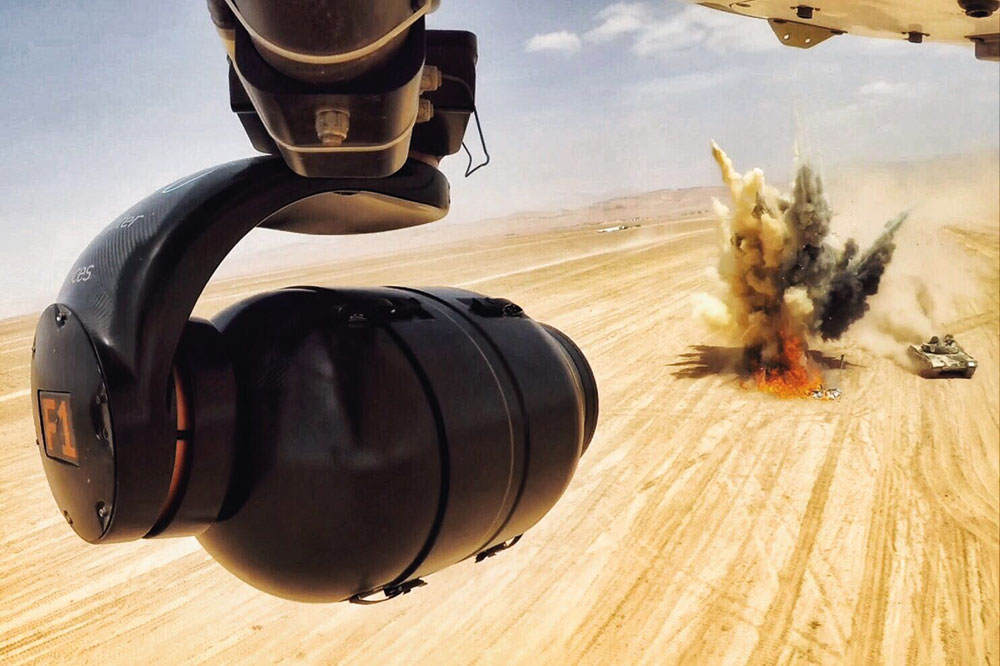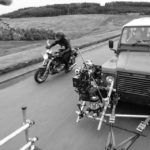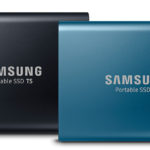
Drones VS Helicopters
Posted on Jun 18, 2018 by Julian Mitchell
Is it a question one of ‘one or the other’ or is it more complicated than that? David Baillie asks the question
Helicopters are expensive. Especially with a fancy gyro-stabilised camera on the front. Current logic has it that drones are cheaper. After all, a drone is just a few rotating butchers’ blades held together by bits of carbon fibre and powered by some fancy batteries that haven’t heard of the Duracell bunny. But as an aerial DOP who works with both, I’m increasingly unconvinced by the economics of the rate card.
Don’t get me wrong, drones are amazing. My gripe is with the system that means the decision on whether to book a drone or a helicopter is usually based on the day rate, rather than cinematographic or financial creativity.
Misconception
There’s a misconception that drones can now do what helicopters used to do. They can’t. They can do incredible things, including much that a helicopter can’t; they can take your camera through open windows, let it drift down forest tracks, and have been fantastic in sports coverage and upping the game of programmes like Grand Designs. But if you need a sweeping shot coming in off the sea
on the Northumberland coast in winter, I’d put my money on a helicopter any day.
Drones don’t do wind, and they don’t do endurance. Mixing blustery wind, complicated background artist choreography, and an eight-minute flight duration is a sure-fire way to lose a lot of friends on set and money.
At this point I can feel a budget (is that the collective noun?) of line producers bristling with irritation. And I understand that (some of my best friends are, or were, line producers). Helicopters are expensive. But if you’re shooting somewhere likely to be windy, at least you’ll get the shot with a 2000kg helicopter, you won’t with a 20kg drone.
But there are even better ways to make helicopters pay their way. And for me this is the nub of the problem. Too often we aerial DOPs are booked at the last minute on the basis of getting a couple of shots on one day’s shoot of one episode of a drama series. If I was ever granted three wishes by a passing fairy godmother, my first would be the chance to sit down with the line producer at the planning stage of a shoot and show how they can wring the maximum value from an aerial shoot, be it drone or helicopter. (My second would be for an ALEXA LF, and the third is beyond the scope of this article.)
Planning
 Helicopters have the edge on drones for fast longer focal length work but the new DJI X7 drone can replicate that
Helicopters have the edge on drones for fast longer focal length work but the new DJI X7 drone can replicate that
If producers, directors and main unit DOPs engage with us at the planning stage we can offer two important services, which I wouldn’t even charge for. The first is our creative judgement, based on experience, as to whether the aesthetic and mood the director and main unit DOP are after is best achieved by hanging the camera under a drone or a helicopter. And there will be many times when a drone is the right choice. There may also be times when a stabilised head on a Russian arm might be a better bet.
But if we feel the camera does need to leave terra firma to tell the story, and we reckon a helicopter is the most likely way to guarantee the shot, then we can also suggest ways to get more bang for your buck. A fair chunk of the cost of a helicopter shoot is the stabilised system on the nose and the money you’ve spent flying it to your location. Once it’s on location, the only extra cost is the flying time. And the more you fly and the more we shoot, the more value you’re getting for those fixed costs.
So what else can we do with a helicopter if we are in at the planning stage? Well here’s one example. Some years ago I shot some aerials on a drama. The scene involved a chase between two quad bikes on open ground. We did the planned aerials in a couple of takes and landed. Nearby the grips were still struggling to rig a Libra mount to the camera quad for a lower level tracking shot.

We had a quiet word with the director and reminded him that helicopters can fly at any height, including the couple of feet above ground planned for the lens on the tracking quad. Within five minutes we were airborne and knocking off tracking shots so low that we got mud from the action quad’s wheels on the camera. If we’d been involved at the planning stage on a similar shoot we might have saved the production the cost of that tracking vehicle.
Another clever trick of helicopters is zipping around very fast. And carrying people. So if you need a dramatic establisher of a character or two in a different location, pop them in the helicopter, we’ll fly to that location, drop them off, shoot them, and bring them back. What’s more we’ll shoot some GVs on the way there and back.
Shotover
There’s no end to the number of useful extra shots we can get if we’re in at the planning stage. If an aerial shoot is budgeted for block one of a series, but block two could do with some dramatic sunsets, and we know that in advance, we might be able to pick those up on our flight back to base.
And just to show what a fair-minded aerial DOP I am, here’s a money-saving tip for a drone booking. The new Shotover U1 drone has a Shotover G1 gimbal hanging underneath it. And guess what? It comes off and can be fixed to a tracking vehicle or a boat. Yet more bang for your buck and less time for your aerial DOP to be left hanging around the catering truck.
Since that fairy godmother hasn’t turned up, here’s an open request to directors and line producers: if you think you want aerial shots of any kind, talk to us in pre-production. Use our experience to help you choose between a drone and a helicopter, and listen to how we can give you the best value for money for either. I guarantee there will be times when a helicopter is cheaper than a drone.

Are drones cheaper than helicopters?
Five industry experts answer the question
Monica Wyer, Aerial DOP & OPs manager, Flying TV
Well that says everything that is wrong with the perception of drones, doesn’t it? It implies they’re interchangeable – the helicopter’s obsolete and the drones are taking over.
But I think attitudes in that respect are changing. Flying TV’s in a quite exclusive club in that we offer both helicopters and drones. I saw a definite shift towards drones for factual telly in 2014-15, mostly due to the perceived cost saving, but the past year has seen a swing back in the opposite direction. Directors have got the novelty factor of it out of their system; producers are seeing the benefit of both options; and production managers are starting to realise that they’re not the great cost saving they may appear. Especially when compared to the rates we have for helicopter work at Flying TV.
Drones have found their place in the box of toys that production can draw on – they’re here to stay. At the DJI end of the market they are becoming just another tool the working cameraman can pull out of the boot for that little extra added value. At the higher end of the market shooting on 35 sensor cameras, where you’re going to have to spend upwards of £50k to get equipped, it’s really settled down with just a handful of professional companies doing the lion’s share of the work.
Chris Bradbury, Director and senior pilot-in-command, Altitude Photography
From our experience at Altitude Photography, using drones is definitely the cheaper option if calculated purely on a cost per hour basis. However, even as drone specialists we’re more than happy to accept that helicopters have their place.
In our opinion the method you choose should purely be based on the shot you require, the safety and legality of either option, as well as the workflow you have planned. The pros and cons of each system should then be weighed up against the cost to decide which option is most practical and cost effective in the long run, as having to reshoot anything is likely to be far more expensive.
My advice to anyone looking to use either option is to speak to us directly to confirm what can be done safely and within the limits of the aircraft, while still fitting the creative needs of your project.
Adam Sculthorp, Head of cameras, Flying Pictures
Determining if an aerial sequence is best achieved by helicopter or drone is an increasing topic of conversation. Five years ago, some considered drones a cheap replacement for helicopters. However, they are very different tools offering different shot dynamics. Today, many directors and producers we work with see drones as a way of achieving a low-level shot not possible with any other tool, be it crane or cable-cam.
Our approach is to deconstruct the sequence and help advise which tool will best achieve the requested results in the simplest and most cost-effective manner. Of course, one of the advantages that we have is being able to not only offer both platforms but also combining the strengths of both on a single production or even a single VFX assisted ‘continuous’ shot (something that you will be able to see on the big screen later this year).
Jeremy Braben, DOP and CEO, Helicopter Film Services
In a word, yes. However, when all things are considered, the actual cost between using a helicopter and using a drone can be surprisingly close. The real question is, is a drone the right tool for the job? Is a helicopter the right tool? Once we have taken a brief from the director, we would advise the best tool to accomplish the shots required rather than be dictated by budget. Quite often, there is the belief that drones are cheaper, and of course on paper they are, especially the small drone systems. However, those have restrictions and constraints – as do helicopters – but the bigger drones capable of flying the ALEXA and RED cameras are more expensive: once you factor in parameters such as wind, environment, distance and speed, the helicopter starts to close the financial and production value gaps by being able to cover off more shots over a larger distance at greater speeds than a drone, and in conditions that potentially ground a drone.
The flip side is, for shorter, closer and lower distances, the drone works better and, yes, is significantly cheaper. However, if a helicopter can do it in a few hours, and the drone takes a few days, you can see where the economies start to change.
Matt Coyde, Sales director, ACS
The ACS aerial unit operates an Inspire 2 UAV alongside a fleet of gyro-stabilised helicopter mounts; all have their part to play in aerial filming.
We see the Inspire 2 as a complimentary product to our more traditional helicopter work and in fact we have successfully delivered several projects using this drone with a separate helicopter to provide a diverse range of aerial imagery which would not have been achievable using one system type alone. Both drone and helicopter have their own unique strengths and weaknesses so it’s a case of determining which option best suits the filming requirement and available budget.
With helicopters you benefit from much longer endurance, range, filming height and camera system payload capability, plus currently, there’s not as much paperwork or flight planning involved!
A drone enables you to get closer to the action and you can dynamically shoot in the space between the ground and the air, eg. horizontal, vertical or extended jib-like movements. Given the limited flight time and payload capability as well as operating restrictions we still tend to turn to helicopters for live coverage, although with continued improvements in drone technology this is likely to change.













